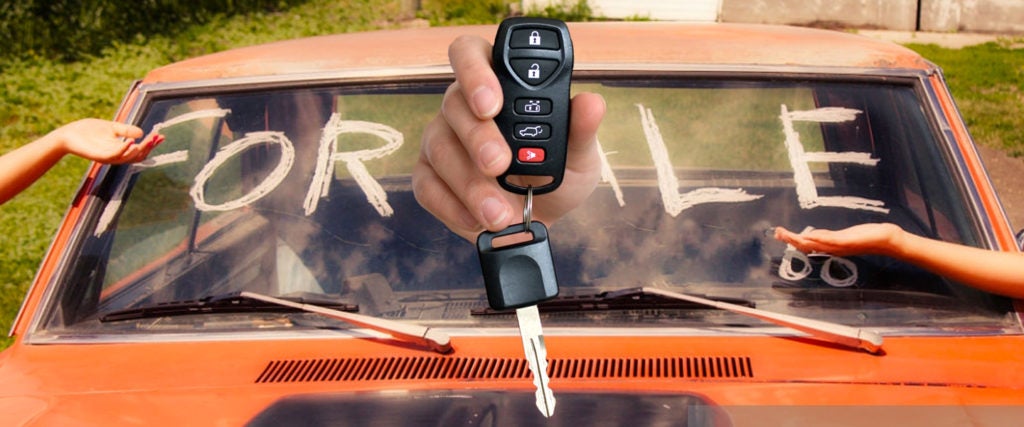If the modern automobile had a status on Facebook, it would undoubtedly be “It’s complicated.” With their computer-controlled fuel-injection systems, continuously variable transmissions and three-phase four-pole AC induction motors, the days when every Tom, Dick or Harry could wrench on their ride seem long gone. So let us help — especially with the seemingly mundane stuff that if not done properly, your dad and/or his favorite mechanic vowed would ruin your car forever. Because when it comes to cars — and this column — no question is too dumb.
I’m planning on getting my soon-to-be 16-year-old a car for their birthday. Problem is, I’m overwhelmed by the idea of picking out the perfect ride. So help me out — what’s the most important stuff I should be looking for?
Well look at you, Mr. Moneybags! Must be pretty nice for your kid that their pops wants to hand over the keys to a brand-spanking-new car.
As for the aforementioned important stuff that should, um, drive that purchase, Tony Vargas, a salesperson at a high-end dealership in the Chicago area, explains, “There are four things every parent of a first-time driver should look for in their child’s first car: A vehicle that’s reliable, safe, affordable to drive and inexpensive to buy. Everything else is a bonus.”
What does he mean by that exactly?
Let’s take a look…
A Car That’s Inexpensive to Buy
“The first thing is, unless you’ve got money to burn, don’t buy new,” Vargas says. “The value of a new car can drop anywhere from 10 to 20 percent the moment your teen drives it off the lot, so not only is buying new going to cost you a lot up front, you’ll lose even more on the back end when you eventually sell on a rapidly depreciating asset.” A certified pre-owned car, on the other hand, can be sold a few years later for nearly the same amount you bought it for (if treated right). Better yet, it’ll cost you a fraction of a new car’s sticker price.
Another thing to consider is what lesson your teen is learning if you buy them a new car as a gift. Instead, “Set up a payment plan for them to pay you back,” advises redditor Searchlights. “Subsidize the cost if you want, but make him pay you something, even if it’s not a lot. They’ll learn a lot more [about the value of things] that way.”
A Car That’s Affordable To Drive
Depending on what’s in your driveway, it can be expensive just to fire up the engine and take to the open road, which is why it’s important to factor in all the overhead costs when you’re purchasing a vehicle for your child. I’m talking about stuff like gas mileage. Because in L.A. right now, gas is around $3 a gallon. That means if you’re looking at an SUV that gets 20 miles per gallon, a full tank might cost your teen between 50 and 60 bucks. A hybrid, or even a sedan, on the other hand, might do 10, 20 or 30 miles per gallon better, saving a ton of cash in the process.
Also, in a lot of states, registration fees are calculated by taking a percentage of the car’s Fair Market Value (FMV). In California, for example, if you buy a $30,000 car, the registration fee will be $195 (or .65% of the FMV). The registration of a $2,000 used car, meanwhile, would obviously be far lower.
A Car That’s Reliable
Speaking of affordability, you know what isn’t affordable? A car that breaks down all the time, and costs a ton of money to fix. “The brand of car that I sell, I’d never recommend to a parent buying something for their child,” says Vargas. “They cost a fortune to repair, and they’re well-known for constantly being in the shop.”
Teenagers aren’t going to take too kindly to driving something that’s frequently breaking down on the side of the road. That’s why putting metaphorical training wheels on their first car by giving them something reliable with only regularly scheduled maintenance to worry about is the best way to teach them how to responsibly take good care of their things. (Owning a car that doesn’t fall apart at the drop of a hat means a higher resale value, too.)
“The first place I’d look for information about reliability would probably be Consumer Reports,” Vargas recommends. “It’s a nonprofit, so you can be reasonably certain that the reviews aren’t bought. You can also check out online message boards, and use Google. There are some brands that are well-known to produce reliable cars, and others that aren’t — like mine.”
A Car That’s Safe
You’re probably asking yourself, “Aren’t all cars relatively safe now?”
Yes and no.
“It’s true that unless you’re buying a really old used car, you’re looking at a relatively high level of safety no matter what you buy,” Vargas tells me. “But there are still some things to consider. For example, if safety is a priority, I’d never recommend the smallest, cheapest car you can find. Compact cars are typically the least safe car you can drive, because, in the case of a collision versus pretty much anything else, they lose.”
That said, anything with too much acceleration is dangerous as well, because fast cars are hard to control and tempting to drive recklessly. “What you really want is something with a good amount of mass that’s slow and with airbags and ABS brakes, bare minimum,” Vargas explains.
As such, he continues, “I’d recommend a gently used sedan from a Japanese or Korean manufacturer, like your Toyota Corollas, your Honda Civics or your Subaru Outbacks. They’re not that expensive to buy, especially pre-owned; they maintain a lot of their value, because they’re so popular; you can beat the shit out of them and they won’t cost you much extra because they’re so reliable; and they’re built like tanks while not being super small or super fast.”
Whatever you end up buying, just remember: Your teen is probably going to be disappointed, because teens are impossible to please. So you might as well make sure they’ll be disappointed safely (and affordably).

